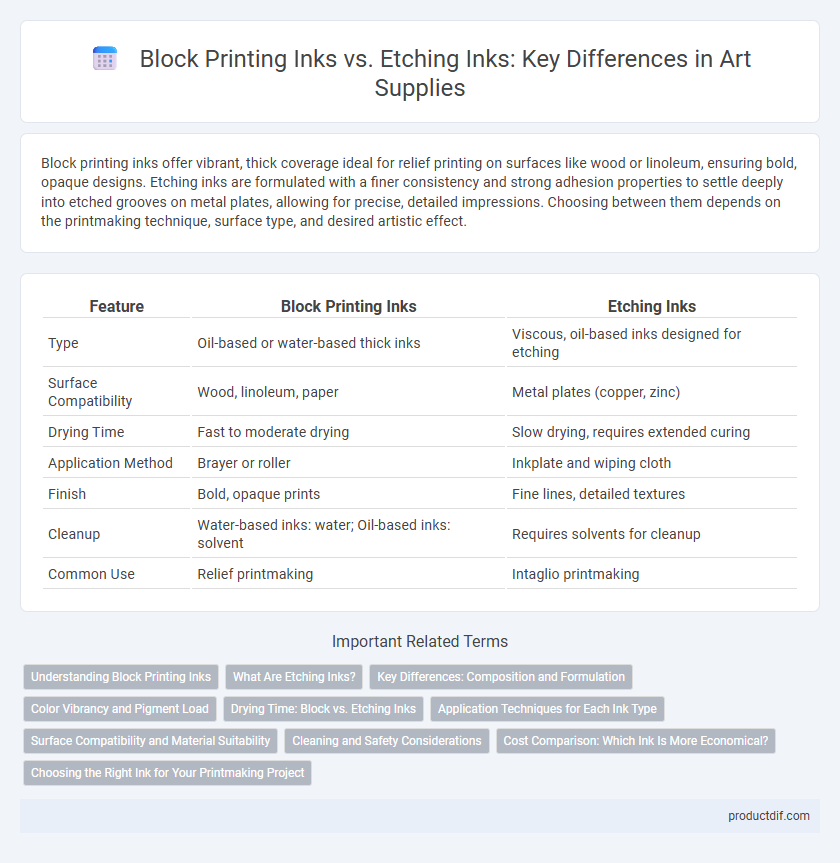Block printing inks offer vibrant, thick coverage ideal for relief printing on surfaces like wood or linoleum, ensuring bold, opaque designs. Etching inks are formulated with a finer consistency and strong adhesion properties to settle deeply into etched grooves on metal plates, allowing for precise, detailed impressions. Choosing between them depends on the printmaking technique, surface type, and desired artistic effect.
Table of Comparison
| Feature | Block Printing Inks | Etching Inks |
|---|---|---|
| Type | Oil-based or water-based thick inks | Viscous, oil-based inks designed for etching |
| Surface Compatibility | Wood, linoleum, paper | Metal plates (copper, zinc) |
| Drying Time | Fast to moderate drying | Slow drying, requires extended curing |
| Application Method | Brayer or roller | Inkplate and wiping cloth |
| Finish | Bold, opaque prints | Fine lines, detailed textures |
| Cleanup | Water-based inks: water; Oil-based inks: solvent | Requires solvents for cleanup |
| Common Use | Relief printmaking | Intaglio printmaking |
Understanding Block Printing Inks
Block printing inks are specially formulated for relief printing techniques, characterized by their thick consistency and vibrant pigmentation that adheres well to raised surfaces. These inks dry quickly and provide excellent coverage on various materials such as paper, fabric, and wood. Understanding the viscosity and drying properties of block printing inks is essential for achieving crisp, detailed prints without smudging or uneven application.
What Are Etching Inks?
Etching inks are specially formulated pigments designed for intaglio printmaking techniques, where ink is applied to a metal plate etched with fine lines. These inks possess a thick, viscous consistency that adheres well to the recessed areas of the plate, ensuring sharp, detailed prints. Unlike block printing inks, etching inks contain a balance of oil and wax to optimize drying time and durability during the printing process.
Key Differences: Composition and Formulation
Block printing inks are typically oil-based or water-based with a thick, paste-like consistency designed for smooth application on relief surfaces. Etching inks contain finer pigments suspended in a more fluid oil base to penetrate the grooves of intaglio plates effectively. The differing formulations affect drying times, adhesion, and the types of surfaces each ink adheres to, making block printing inks ideal for raised designs and etching inks suitable for detailed line work in intaglio printing.
Color Vibrancy and Pigment Load
Block printing inks typically feature higher pigment load and yield vibrant, opaque colors ideal for bold designs on paper, fabric, and wood. Etching inks, in contrast, often possess a thinner consistency with more translucent color qualities suited for fine detail work on metal plates. The choice between the two inks impacts the final artwork's color intensity, with block printing inks providing richer saturation and etching inks offering subtle tonal gradations.
Drying Time: Block vs. Etching Inks
Block printing inks typically dry faster due to their oil-based or water-based formulations, allowing artists to layer colors more quickly without smudging. Etching inks, designed for intaglio printmaking, have a slower drying time because they stay tacky longer to ensure fine detail transfer from etched plates. Understanding these drying time differences helps artists choose the right ink for their printmaking technique and workflow efficiency.
Application Techniques for Each Ink Type
Block printing inks are thick and viscous, designed to adhere well to relief surfaces, making them ideal for stamping and pressing onto paper or fabric with rollers or brayers. Etching inks possess a softer, oil-based consistency, allowing them to fill fine lines and recessed areas of metal plates, requiring careful wiping to achieve detailed intaglio prints. Each ink's unique texture and application method directly influence the precision and final appearance of prints in traditional block printing versus etching techniques.
Surface Compatibility and Material Suitability
Block printing inks are formulated to adhere effectively to porous surfaces such as paper, fabric, and wood, making them ideal for relief printing on materials with texture. Etching inks, by contrast, are designed for smooth, non-porous surfaces like metal plates, facilitating precise detail capture in intaglio printmaking. Selecting the appropriate ink depends on the printing surface and the desired durability and clarity of the final artwork.
Cleaning and Safety Considerations
Block printing inks are typically water-based or oil-based and easier to clean with soap and water or mineral spirits, while etching inks require solvents like turpentine or specialized cleaners due to their oil-based composition. Proper ventilation and gloves are essential when handling etching inks to avoid skin irritation and inhalation of harmful fumes. Safe disposal practices for both ink types help minimize environmental impact and maintain a clean workspace.
Cost Comparison: Which Ink Is More Economical?
Block printing inks typically cost less per ounce than etching inks due to simpler formulations and lower pigment concentrations, making them more economical for large-scale projects. Etching inks, designed for metal plates and demanding higher pigment density and binding agents, tend to be pricier but offer superior durability and detail retention. For budget-conscious artists working on paper or textile prints, block printing inks provide a cost-effective solution without sacrificing print quality.
Choosing the Right Ink for Your Printmaking Project
Block printing inks deliver vibrant colors and excellent coverage, perfect for bold, graphic designs on paper or fabric. Etching inks, formulated for intaglio processes, offer rich pigmentation and smooth consistency that settle into fine etched lines, ideal for detailed prints on metal plates. Selecting the right ink depends on your printing technique and desired texture, with block inks suited for relief printing and etching inks optimized for intricate intaglio work.
Block Printing Inks vs Etching Inks Infographic

 productdif.com
productdif.com